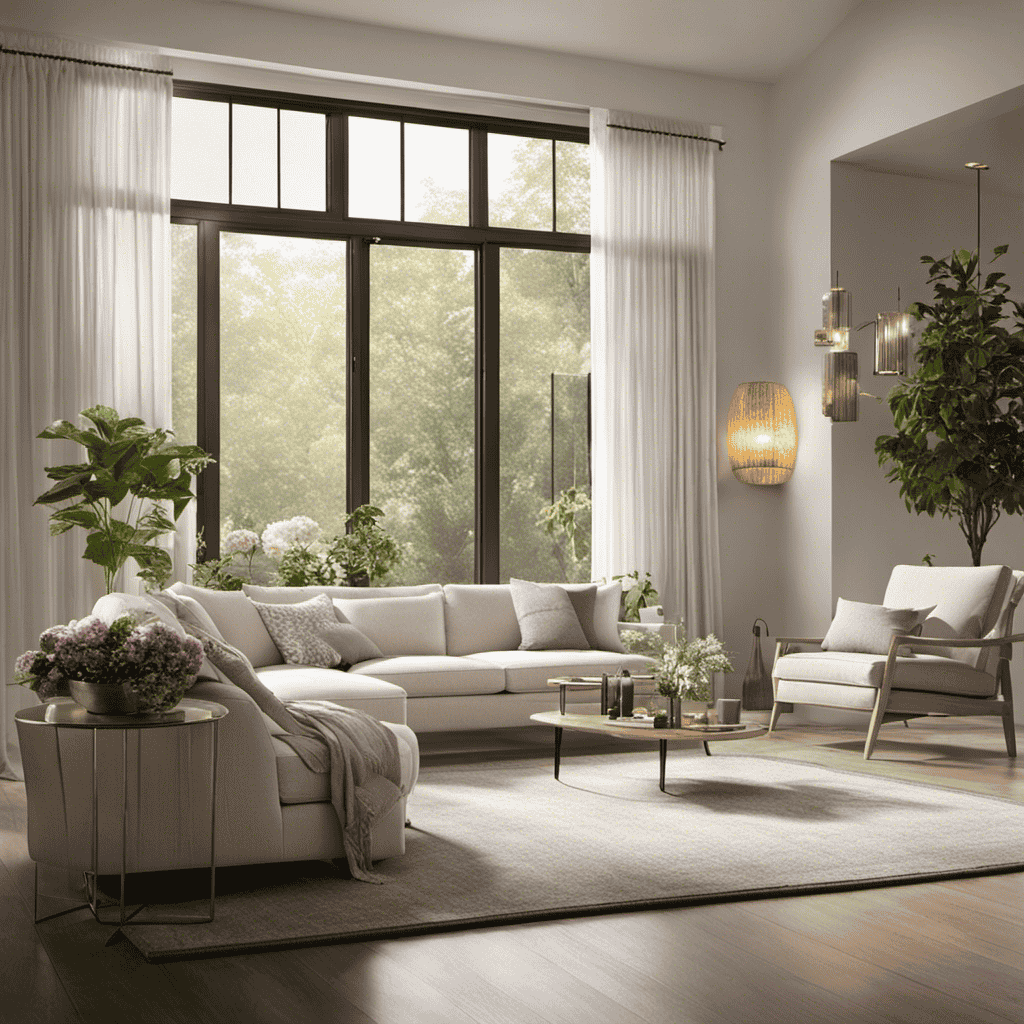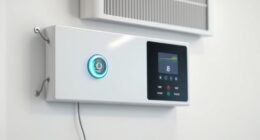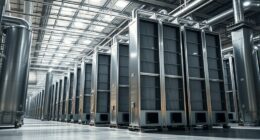I have always appreciated the advantages of having an air purifier in my home, but the continuous noise can be quite annoying.
That’s why I’ve delved into the world of soundproofing techniques to find ways to deaden the sound of my air purifier.
In this article, I’ll share my discoveries on understanding noise levels, identifying the source of the noise, and implementing effective soundproofing techniques.
By the end, you’ll be equipped with the knowledge to enjoy the clean air without the annoying noise.
Key Takeaways
- Decibel ratings measure the intensity of sound produced by air purifiers.
- Identifying the source of the air purifier noise helps in finding a solution.
- Soundproofing techniques, such as foam padding or acoustic panels, can reduce air purifier noise.
- Acoustic panels strategically placed around the room can absorb sound waves and reduce echo.
Understanding the Noise Levels of Air Purifiers
To understand the noise levels of air purifiers, you should check the decibel ratings before making a purchase. Decibels (dB) measure the intensity of sound. Air purifiers typically have decibel ratings ranging from 20 dB to 60 dB. Lower decibel ratings indicate quieter operation, while higher ratings indicate louder operation.
Understanding decibel levels is crucial as it helps you choose an air purifier that fits your noise preferences. If you want to further reduce the noise, you can consider soundproofing materials. These materials absorb or block sound waves, minimizing the noise produced by the air purifier.
Common soundproofing materials include acoustic foam, mass-loaded vinyl, and soundproof curtains. By understanding decibel levels and using soundproofing materials, you can create a quieter and more comfortable environment with your air purifier.
Identifying the Source of the Air Purifier Noise
Identifying where the noise is coming from on your air purifier can help you find a solution. It is crucial to troubleshoot air purifier noise to ensure that your device is working effectively and quietly. Here are some common air purifier issues to look out for:
- Loose parts: Check if any parts, such as the filter or fan, are loose and causing the noise.
- Fan motor: The fan motor may be malfunctioning or worn out, resulting in excessive noise.
- Airflow obstruction: Dust or debris can accumulate inside the air purifier, obstructing the airflow and causing noise.
- Vibrations: Sometimes, the noise can be due to vibrations caused by an unbalanced unit or improper placement.
Soundproofing Techniques for Air Purifiers
Using foam padding or rubber mats underneath the air purifier can help reduce the noise it produces.
However, if you want to take soundproofing to the next level, you can consider using sound absorbing materials and soundproofing curtains.
Sound absorbing materials, such as acoustic panels or foam, can be placed around the air purifier to absorb and dampen the noise. These materials are designed to reduce sound reflections and echoes, resulting in a quieter environment.
Soundproofing curtains, on the other hand, are made of heavy and dense fabrics that effectively block and absorb sound waves. By hanging these curtains around the air purifier, you can significantly reduce the noise level.
It is important to note that while these techniques can help minimize the noise, it is essential to maintain proper ventilation for the air purifier to function effectively.
Using Acoustic Panels to Reduce Air Purifier Noise
When it comes to reducing noise from air purifiers, one effective solution is using acoustic panels.
In this discussion, I will cover three key points related to using acoustic panels: proper placement, material selection tips, and the overall effectiveness of noise reduction.
Acoustic Panel Placement
To effectively deaden the sound of your air purifier, try placing acoustic panels strategically around the room. Acoustic panels are designed to absorb sound waves and reduce echo, making them a great choice for noise reduction in any space.
Here are some tips for acoustic panel installation and sound absorption techniques:
- Position the panels near the air purifier to absorb the sound waves it produces.
- Place panels on the walls and ceiling to create a more balanced sound absorption.
- Consider the size and thickness of the panels to ensure optimal sound absorption.
- Experiment with different panel layouts to find the configuration that works best for your room.
By following these tips, you can effectively reduce the noise generated by your air purifier and create a quieter environment.
Now, let’s move on to the next section where we will discuss material selection tips for acoustic panels.
Material Selection Tips
In my quest to reduce the noise emitted by my air purifier, I have come across various soundproofing materials and noise reduction techniques. Choosing the right materials is crucial for effective sound deadening. Here are some tips to consider:
| Material | Description |
|---|---|
| Acoustic Foam | This lightweight material absorbs sound waves and reduces echo. It is commonly used in recording studios and home theaters. |
| Mass Loaded Vinyl | This dense material blocks sound transmission and is often used in walls, floors, and ceilings. It is highly effective but can be more expensive. |
| Soundproof Curtains | These heavy curtains are made with sound-absorbing materials and can be easily installed to reduce noise. They are a cost-effective solution. |
| Fiberglass Insulation | This material is commonly used for thermal insulation, but it also has sound-absorbing properties. It is easy to install and can be effective in reducing noise. |
| Soundproofing Paint | This special paint contains sound-absorbing additives that reduce noise transmission. It is a simple and affordable option for soundproofing small areas. |
Effectiveness of Noise Reduction
Using the right soundproofing materials and techniques can greatly improve the effectiveness of noise reduction.
When it comes to measuring noise levels, it is important to have accurate tools such as a sound level meter to determine the decibel level of the noise. This allows for a better understanding of the amount of noise reduction required.
Additionally, it is crucial to consider the psychological effects of noise reduction. Excessive noise can lead to stress, sleep disturbances, and decreased productivity. By effectively reducing noise, individuals can experience improved concentration, better sleep quality, and overall well-being.
To achieve optimal noise reduction, it is recommended to use materials like acoustic foam, soundproof curtains, and weatherstripping. These materials help absorb and block sound, creating a quieter and more peaceful environment.
Adjusting Fan Speed to Minimize Sound
You can easily reduce the sound of your air purifier by simply adjusting the fan speed. When the fan speed is set to a lower setting, the air purifier will operate at a quieter level. This is because the fan will rotate at a slower speed, resulting in reduced vibrations and noise.
Additionally, using soundproof curtains can further minimize the sound produced by the air purifier. These curtains are designed to absorb and block sound waves, creating a quieter environment. By placing soundproof curtains around the air purifier, you can effectively deaden the sound and enjoy a more peaceful atmosphere.
Remember to adjust the fan speed and consider using soundproof curtains to achieve a quieter operation of your air purifier.
Exploring Noise Reduction Accessories for Air Purifiers
When it comes to air purifiers, noise can be a major concern. That’s why it’s important to explore options for silent air purifiers that offer effective filtration without the added noise.
Additionally, noise-cancelling air purifiers and soundproofing techniques can also be utilized to minimize the sound produced by these devices.
Silent Air Purifier Options
There are several silent air purifier options available on the market. If you are looking to reduce noise in your home or office, consider these top-rated models:
-
Dyson Pure Cool TP04: This purifier not only cleans the air but also operates almost silently, making it perfect for bedrooms or living rooms.
-
Coway AP-1512HH Mighty: With its advanced filtration system and whisper-quiet operation, this purifier is a popular choice among users looking for a noise-free environment.
-
Rabbit Air MinusA2: This sleek purifier offers customizable settings and operates quietly, ensuring a peaceful and clean environment.
-
Winix 5500-2: Known for its exceptional air cleaning capabilities, this purifier also operates quietly, allowing you to enjoy fresh air without any disturbance.
When selecting a silent air purifier, reading silent air purifier reviews can help you make an informed decision. Additionally, following noise reduction tips such as placing the purifier on a soft surface or using soundproofing materials can further minimize any noise.
Noise-Cancelling Air Purifiers
Now, let’s delve into the world of noise-canceling air purifiers. These innovative devices use advanced noise-canceling technology and noise reduction techniques to minimize the sound produced by air purifiers.
By employing active noise cancellation, these purifiers can create an environment free from the distracting hum and whir typically associated with traditional models. The noise-canceling technology works by analyzing the incoming sound waves and generating inverse sound waves that cancel out the noise.
This results in a quieter operation, allowing you to enjoy clean air without any disturbance. Additionally, noise reduction techniques such as insulated enclosures and vibration dampening materials further contribute to a quieter experience.
With noise-canceling air purifiers, you can now achieve both clean and quiet air in your home or office space.
Soundproofing Air Purifier Techniques
To achieve a quieter operation, you’ll want to explore different techniques for soundproofing your air purifier. Here are some effective methods to consider:
-
Use soundproofing materials: Apply acoustic foam or insulation to the inside walls of the air purifier to absorb and dampen sound waves.
-
Seal gaps and openings: Use weatherstripping or silicone sealant to seal any gaps or openings in the air purifier’s casing to prevent sound leakage.
-
Isolate the motor: Place rubber or foam pads underneath the air purifier to isolate it from the surface it’s sitting on, reducing vibration and noise transmission.
-
Build an enclosure: Construct a wooden or acrylic enclosure around the air purifier, incorporating soundproofing materials within the walls to further block noise.
Maintaining and Cleaning Your Air Purifier for Quieter Operation
Regularly cleaning and maintaining your air purifier will help ensure quieter operation. Cleaning techniques play a crucial role in reducing noise generated by the air purifier.
One effective method is to clean the filters regularly. Dust and debris can accumulate on the filters, causing the fan to work harder and produce more noise. By removing and cleaning the filters according to the manufacturer’s instructions, you can prevent this buildup and minimize noise.
Additionally, keeping the unit free from dust and dirt by wiping it down with a soft, damp cloth will help maintain optimal performance and reduce noise.
Noise reduction methods can also involve inspecting the fan and motor for any loose or damaged parts. Tightening or replacing these components can significantly decrease noise levels.
Frequently Asked Questions
Can I Use Regular Household Items to Soundproof My Air Purifier?
Yes, I can use regular household items to soundproof my air purifier. There are various air purifier noise reduction techniques and DIY soundproofing methods for air purifiers that can effectively reduce the noise.
How Often Should I Clean My Air Purifier to Maintain Its Quiet Operation?
To maintain optimal performance and minimize noise, it is recommended to clean air purifier filters regularly. Regular cleaning improves air quality and prolongs the lifespan of the device.
Are There Any Specific Models or Brands of Air Purifiers That Are Known to Be Quieter Than Others?
Some of the quietest air purifier models on the market include the Dyson Pure Cool TP04 and the Blueair Classic 605. Noise levels can vary among different air purifier brands, so it’s important to compare before purchasing.
Can I Use a Noise Reduction Accessory for My Air Purifier Without Compromising Its Performance?
Using a noise reduction accessory for my air purifier may reduce the sound, but it could also impact its efficiency. It’s important to consider different noise reduction techniques and their potential trade-offs.
Is It Possible to Completely Eliminate the Noise From an Air Purifier, or Can I Only Reduce It to a Certain Extent?
It is possible to reduce the noise from an air purifier to a certain extent. However, completely eliminating the noise may not be achievable. Tips for minimizing air purifier noise disturbance include choosing the right location.
Conclusion
In conclusion, reducing the noise of your air purifier is not impossible. By understanding the noise levels and identifying the source of the noise, you can implement soundproofing techniques to create a more peaceful and quiet environment.
Think of your air purifier as a symphony conductor, orchestrating the harmony of clean air while creating a soothing ambiance. With the right adjustments and maintenance, you can enjoy the benefits of clean air without the disruptive noise.
So, don’t let the noise be the conductor of your discomfort. Take control and create a harmonious atmosphere.










